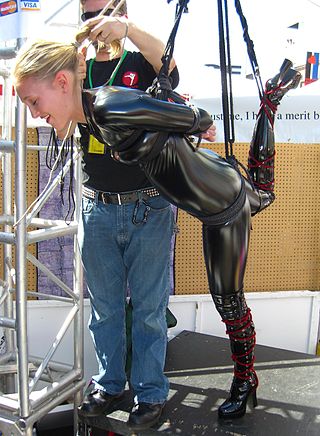
Hojōjutsu or Torinawajutsu or just Nawajutsu, is the traditional Japanese martial art of restraining a person using cord or rope, as a precursor to modern-day handcuffs. Encompassing many different materials, techniques and methods from many different schools, Hojōjutsu is a quintessentially Japanese art that is a unique product of Japanese history and culture.

Bondage, in the BDSM subculture, is the practice of consensually tying, binding, or restraining a partner for erotic, aesthetic, or somatosensory stimulation. A partner may be physically restrained in a variety of ways, including the use of rope, cuffs, bondage tape, or self-adhering bandage.

Kinbaku (緊縛) means "tight binding", while Kinbaku-bi (緊縛美) literally means "the beauty of tight binding". Kinbaku is a Japanese style of bondage or BDSM which involves tying a person up using simple yet visually intricate patterns, usually with several pieces of thin rope. In Japanese this natural-fibre rope is known as asanawa (麻縄). The allusion is to the use of hemp rope for restraining prisoners, as a symbol of power, in the same way that stocks or manacles are used in a Western BDSM context.

Handcuffs are restraint devices designed to secure an individual's wrists in proximity to each other. They comprise two parts, linked together by a chain, a hinge, or rigid bar. Each cuff has a rotating arm which engages with a ratchet that prevents it from being opened once closed around a person's wrist. Without the key, the handcuffs cannot be removed without specialist knowledge, and the handcuffed person cannot move their wrists more than a few centimetres or inches apart, making many tasks difficult or impossible.

Bondage cuffs are restraints designed for use in sexual bondage situations. Compared to conventional handcuffs, they are wide wrist and ankle restraints generally made of leather, often padded with soft leather or fake fur. Bondage cuffs may be fastened at the wrists and/or ankles by a locking mechanism, by a buckle or by velcro. They are secured around the wrist or ankle, and the cuffs may then be attached to each other or another object.

Self-bondage refers to the use of restraints on oneself for erotic pleasure. It is a form of erotic bondage which can be practiced alone.

A spreader bar is an article of bondage equipment usually consisting of a metal or wooden bar, with attachment points for bondage cuffs at each end, which can be fastened to wrists, ankles or knees to hold them apart. They are used in bondage play, and sometimes in bedroom bondage, usually in association with other bondage equipment.

Bondage in BDSM is the activity of tying or restraining people using equipment such as chains, cuffs, or collars for mutual erotic pleasure. According to the Kinsey Institute, 12% of females and 22% of males respond erotically to BDSM.

The spreadeagle is the position in which a person has their arms outstretched and legs apart, figuratively resembling an eagle with wings spread. It is a style that appears commonly in nature and geometry. In human style, it is represented by the letter "X".

Suspension bondage is a form of sexual bondage where a bound person is hung from one or more overhead suspension points. It carries a higher risk than other forms of sexual bondage.

A bondage rigger is a person who practices the art of bondage, using any of a variety of materials such as rope, leather straps, or metal restraints.

Chinese jump rope, also known as Chinese ropes, jumpsies, elastics, rek, yoki (Canada), Super Cali (Newfoundland), French skipping, American ropes/Chinese ropes, gummitwist, "jeu de l elastique" in France and Chinese garter in the Philippines is a children's game resembling hopscotch and jump rope. Various moves are combined to create patterns which are often accompanied by chants.
Chinese jump rope combines the skills of hopscotch with some of the patterns from the hand-and-string game cat's cradle. The game began in 7th-century China. In the 1960s, children in the Western hemisphere adapted the game. German-speaking children call Chinese jump rope gummitwist and British children call it elastics. The game is typically played in a group of at least 3 players with a rope approximately 16 feet in length tied into a circle. Traditional Chinese jump ropes are strings of rubber bands tied together, but today many varieties of commercial rope exist. Two players face each other standing 9 feet apart, and position the rope around their ankles so that it is taut. The third player stands between the two sides of the rope and tries to perform a designated series of moves without making an error or pausing.

The X-cross, X-frame, saltire cross or Saint Andrew's cross is a common piece of equipment in BDSM dungeons. It is erotic furniture that typically provides restraining points for ankles, wrists, and waist. When secured to an X-cross, the subject is restrained in a standing spreadeagle position.

A nawashi is a person with a recognized proficiency in the historic erotic art of Japanese bondage. The word nawashi is used in SM circles to mean "rope artist".

Breast torture is a BDSM activity in which sexual stimulation is provided through the intentional application of physical pain or constriction to the breasts, areolae or nipples of a submissive. It is a popular activity among the kink community. The recipient of such activities may wish to receive them as a result of masochism or they may have a desire to please a dominant who is sadistic. Those involved may also be motivated by breast fetishism. Mild breast torture such as light impact play on the breasts is also occasionally used outside of the BDSM context to provide stimulation and pleasure during conventional sex. While breast and nipple torture is usually performed on women, most techniques or methods may also be used on men.

An armbinder or monoglove is a type of restraint device primarily used in bondage play, designed to bind the arms and/or hands to each other or to the body, usually behind the back, and employing a range of bondage equipment including cuffs, rods, straps, and gloves.

Limb restraints can be physical restraints that inhibit an individual's movement in their arms or legs. The most common limb restraint is physical, whereby restraints are fixed to the individual in order to prevent movement of the limbs. They are most commonly used within the field of medicine. However, opposed to physical restraints, chemical restraints are forms of psychoactive medication that intentionally inhibit an individual's behaviour or movement.

A lead, lead line, lead rope (US) or head collar rope (UK), is used to lead an animal such as a horse. Usually, it is attached to a halter. The lead may be integral to the halter or, more often, separate. When separate, it is attached to the halter with a heavy clip or snap so that it can be added or removed as needed. A related term, lead shank or lead chain refers to a lead line with a chain attached that is used in a variety of ways to safely control possibly difficult or dangerous horses if they will not respond to a regular lead.

Lee Harrington is a sexuality and spirituality educator, author, and artist, currently based in Denver, Colorado. Born in Lowell, Massachusetts, he began transitioning from female to male in 2007.
























